Investigation of a New Strengthening Technique for RC Deep Beams Using Carbon FRP Ropes as Transverse Reinforcements
Abstract
1. Introduction
2. Experimental Program
2.1. Materials
2.2. FRP Strengthening Techniques
2.3. Test Setup and Instrumentation
3. Test Results and Commentary
4. Analytical Predictions
4.1. Strengthened Beam with Rectangular Cross-Section
Contribution of the FRP Ropes Using the ETS System
4.2. Strengthened Flanged Beam with T-Shaped Cross-Section
Contribution of the FRP Ropes Using the NSM System
4.3. Prediction of the Expected Failure Mode
5. Concluding Remarks
Supplementary Materials
Author Contributions
Funding
Acknowledgments
Conflicts of Interest
Glossary/Nomenclature/Abbreviations
| Af | cross-sectional area of the impregnated fibre-reinforced polymer (FRP) rope (mm2) |
| Asw | cross-sectional area of the steel transverse reinforcement (mm2) |
| bef | effective flange width (mm) |
| bf | flange width of the T-shaped cross-section (mm) |
| bw | web width of the T-shaped cross-section (mm) |
| C | concrete compression force (kN) |
| c | neutral axis depth (mm) |
| cnom | clear concrete cover thickness (mm) |
| cs | depth of the compression zone above the tip of the shear critical crack (mm) |
| d | effective depth of the cross-section (mm) |
| df | nominal diameter of the impregnated FRP rope (mm) |
| dfv | effective shear depth (the greater of 0.72h and 0.9d) (mm) |
| Ef | modulus of elasticity of the impregnated FRP rope (GPa) |
| fc | cylinder compressive strength of concrete (MPa) |
| fyw | yield tensile strength of the transverse steel reinforcement (MPa) |
| h | height of the cross-section (mm) |
| hf | height of the flange of the T-shaped cross-section (mm) |
| My,calc | flexural strength at yielding of the longitudinal reinforcement (kNm) |
| Mu,calc | ultimate flexural strength (kNm) |
| s | uniform spacing of the steel transverse shear reinforcement (mm) |
| sf | uniform spacing of the impregnated FRP ropes (mm) |
| T | normal tension force of the longitudinal reinforcement (kN) |
| PMy,calc | calculated total strength corresponding to the flexural strength at yielding of the longitudinal reinforcement (kN) |
| PMu,calc | calculated total strength corresponding to the ultimate flexural strength (kN) |
| VVu,calc | ultimate shear strength (kN) |
| Vu,exp | experimental shear strength (kN) |
| PVu,calc | calculated total strength corresponding to the ultimate shear strength (kN) |
| Pu,exp | ultimate experimental applied load (kN) |
| z | lever arm (mm) |
| α | shear span (mm) |
| αb | bond parameter derived from pull-out tests and defined by Cosenza et al. [25] |
| εf | effective strain in the principal direction of the fibres of the FRP rope (%) |
| θf | inclination angle of the impregnated FRP rope with respect to the beam longitudinal axis (deg) |
| ρsw | steel transverse reinforcement ratio equal to Asw/bws (%) |
| φ | inclination angle of the shear critical crack (deg) |
References
- Karayannis, C.G.; Chalioris, C.E. Experimental investigation of the contribution of bonded C-FRP jackets to shear capacity of RC beams. In Proceedings of the International Symposium Celebrating Concrete: People and Practice, Dundee, UK, 3–4 September 2003; pp. 689–696. [Google Scholar]
- Bencardino, F.; Spadea, G.; Swamy, R.N. The problem of shear in RC beams strengthened with CFRP laminates. Constr. Build. Mater. 2007, 21, 1997–2006. [Google Scholar] [CrossRef]
- Karayannis, C.G.; Sirkelis, G.M. Strengthening and rehabilitation of RC beam-column joints using carbon-FRP jacketing and epoxy resin injection. Earthq. Eng. Struct. Dyn. 2008, 37, 769–790. [Google Scholar] [CrossRef]
- Tsonos, A.G. Effectiveness of CFRP-jackets and RC-jackets in post-earthquake and pre-earthquake retrofitting of beam-column subassemblages. Eng. Struct. 2008, 30, 777–793. [Google Scholar] [CrossRef]
- Ombres, L. Structural performances of reinforced concrete beams strengthened in shear with a cement based fiber composite material. Compos. Struct. 2015, 122, 316–329. [Google Scholar] [CrossRef]
- Barros, J.A.O.; Dias, S.J.E. Assessment of the effectiveness of the NSM shear strengthening technique for deep T cross section RC beams. In Proceedings of the 11th International Symposium on Fiber Reinforced Polymers for Reinforced Concrete Structures FRPRCS11, Guimarães, Portugal, 26–28 June 2013. [Google Scholar]
- Seo, S.-Y.; Feo, L.; Hui, D. Bond strength of near surface-mounted FRP plate for retrofit of concrete structures. Compos. Struct. 2013, 95, 719–727. [Google Scholar] [CrossRef]
- De Lorenzis, L.; Nanni, A. Shear strengthening of reinforced concrete beams with near-surface mounted fiber-reinforced polymer rods. ACI Struct. J. 2001, 98, 60–68. [Google Scholar]
- Bilotta, A.; Ceroni, F.; Di Ludovico, M.; Nigro, E.; Pecce, M.; Manfredi, G. Bond efficiency of EBR and NSM FRP systems for strengthening concrete members. ASCE J. Compos. Constr. 2011, 15, 757–772. [Google Scholar] [CrossRef]
- Parvin, A.; Syed Shah, T. Fiber Reinforced Polymer Strengthening of Structures by Near-Surface Mounting Method. Polymers 2016, 8, 298. [Google Scholar] [CrossRef]
- Oehlers, D.J.; Haskett, M.; Wu, C.; Seracino, R. Embedding NSM FRP plates for improved IC debonding resistance. ASCE J. Compos. Constr. 2008, 12, 635–642. [Google Scholar] [CrossRef]
- Breveglieri, M.; Aprile, A.; Barros, J.A.O. Embedded through-section shear strengthening technique using steel and CFRP bars in RC beams of different percentage of existing stirrups. Compos. Struct. 2015, 126, 101–113. [Google Scholar] [CrossRef]
- Mofidi, A.; Chaallal, O.; Benmokrane, B.; Neale, K. Experimental tests and design model for RC beams strengthened in shear using the embedded through-section FRP method. ASCE J. Compos. Constr. 2012, 16, 540–550. [Google Scholar] [CrossRef]
- Breveglieri, M.; Aprile, A.; Barros, J.A.O. Embedded through-section shear strengthening technique using steel bars. Eng. Struct. 2014, 81, 76–87. [Google Scholar] [CrossRef]
- Chaallal, O.; Mofidi, A.; Benmokrane, B.; Neale, K. Embedded through-section FRP rod method for shear strengthening of RC beams: Performance and comparison with existing techniques. J. Compos. Constr. 2011, 15, 374–383. [Google Scholar] [CrossRef]
- Yang, K.H.; Byun, H.Y.; Ashour, A.F. Shear strengthening of continuous reinforced concrete T-beams using wire rope units. Eng. Struct. 2009, 31, 1154–1165. [Google Scholar] [CrossRef]
- Chalioris, C.E.; Papadopoulos, N.A.; Panagiotopoulos, T.A.; Kosmidou, P.-Μ.K. Shear strengthening of reinforced concrete deep beams without stirrups using carbon fibre rope as transverse link reinforcement. In Proceedings of the 12th Annual International Conference on Composites/Nano Engineering ICCE-25, Rome, Italy, 16–22 July 2017. [Google Scholar]
- Rousakis, T.C. Hybrid confinement of concrete by Fiber-Reinforced Polymer sheets and fiber ropes under cyclic axial compressive loading. ASCE J. Compos. Constr. 2013, 17, 732–743. [Google Scholar] [CrossRef]
- El-Saikaly, G.; Godat, A.; Chaallal, O. New anchorage technique for FRP shear-strengthened RC T-beams using CFRP rope. ASCE J. Compos. Constr. 2015, 19. [Google Scholar] [CrossRef]
- Kaya, E.; Kütan, C.; Sheikh, S.; İlki, A. Flexural retrofit of support regions of reinforced concrete beams with anchored FRP ropes using NSM and ETS methods under reversed cyclic loading. ASCE J. Compos. Constr. 2017, 21, 1574–1582. [Google Scholar] [CrossRef]
- Parretti, R.; Nanni, R. Strengthening of RC members using near-surface mounted FRP composites: Design overview. Adv. Struct. Eng. 2004, 7, 469–483. [Google Scholar] [CrossRef]
- ACI (American Concrete Institute). Guide for the Design and Construction of Externally Bonded FRP Systems for Strengthening Concrete Structures; ACI-440.2R-08; American Concrete Institute (ACI): Farmington Hills, MI, USA, 2008; p. 76. [Google Scholar]
- Karayannis, C.G.; Chalioris, C.E. Shear tests of reinforced concrete beams with continuous rectangular spiral reinforcement. Constr. Build. Mater. 2013, 46, 86–97. [Google Scholar] [CrossRef]
- Zararis, P.D. Shear compression failure in reinforced concrete deep beams. ASCE J. Struct. Eng. 2003, 129, 544–553. [Google Scholar] [CrossRef]
- Cosenza, E.; Manfredi, G.; Realfonzo, R. Development length of FRP straight rebars. Compos. Part B 2002, 33, 493–504. [Google Scholar] [CrossRef]
- Godat, A.; L’Hady, A.; Chaallal, O.; Neale, K.W. Bond Behavior of the ETS FRP Bar shear-strengthening method. ASCE J. Compos. Constr. 2012, 16, 529–539. [Google Scholar] [CrossRef]
- Zararis, I.P.; Karaveziroglou, M.K.; Zararis, P.D. Shear strength of reinforced concrete T-beams. ACI Struct. J. 2006, 103, 693–700. [Google Scholar]
- Bencardino, F.; Colotti, V.; Spadea, G.; Swamy, R.N. Holistic design of RC beams and slabs strengthened with externally bonded FRP laminates. Cem. Concr. Compos. 2006, 28, 832–844. [Google Scholar] [CrossRef]

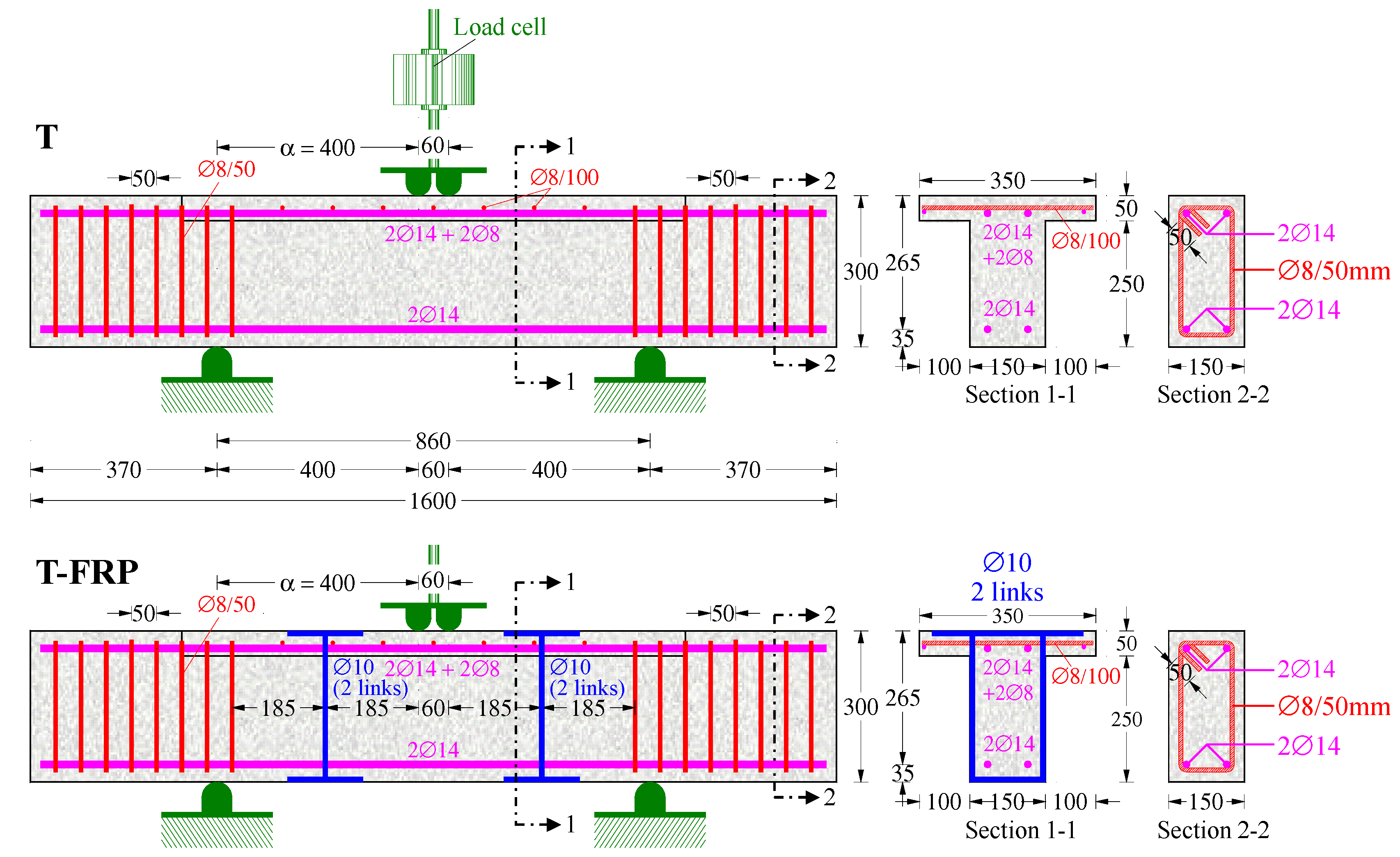
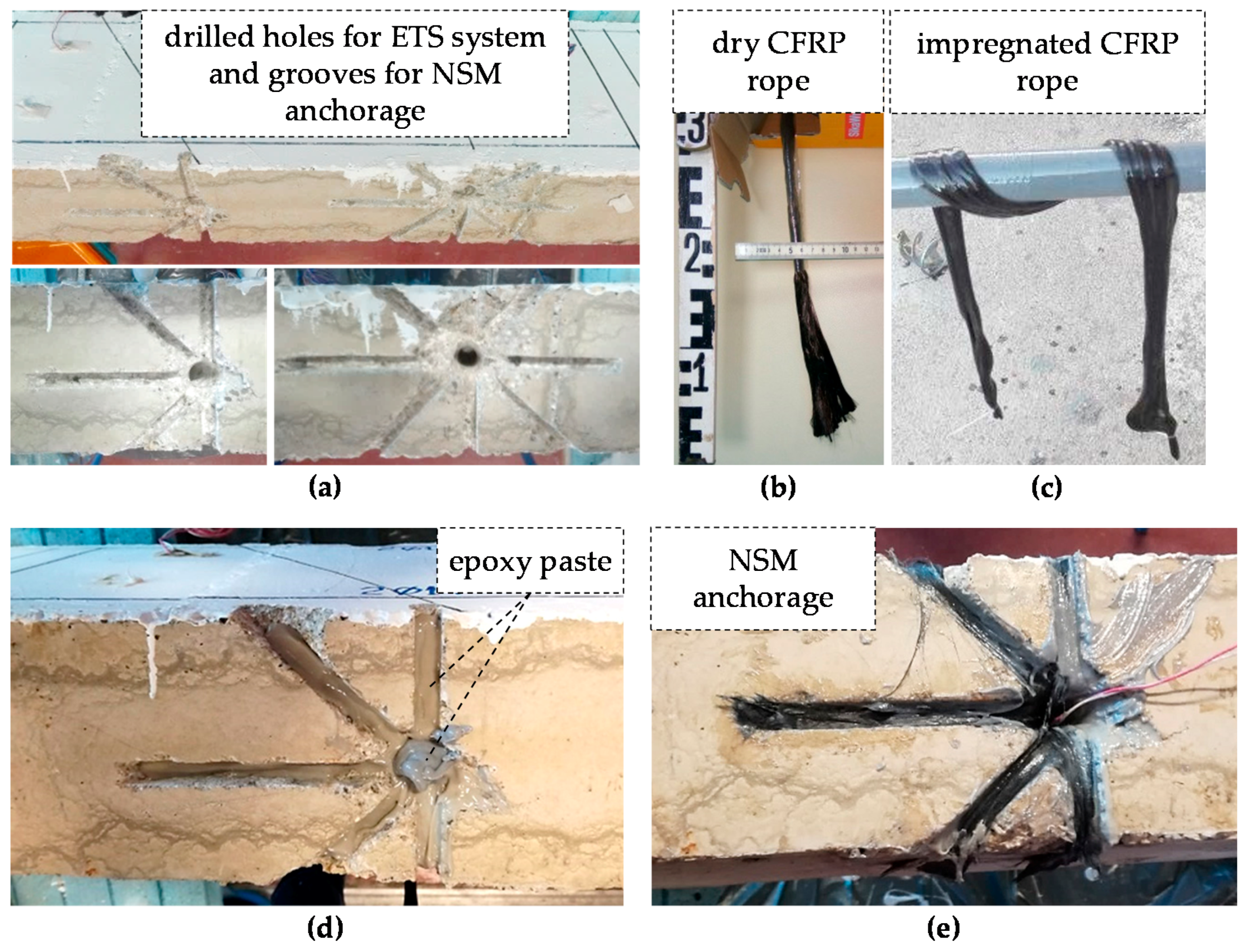


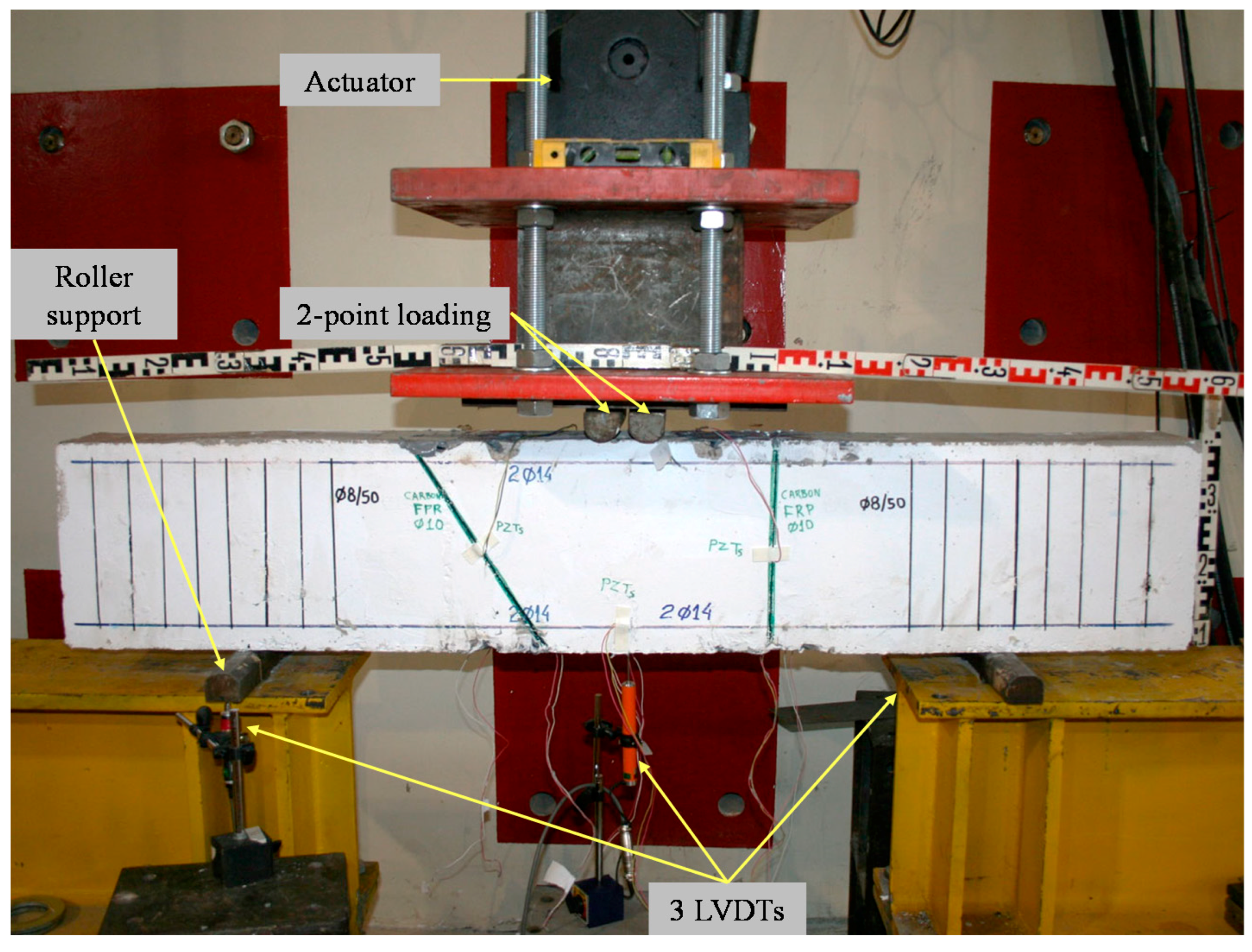
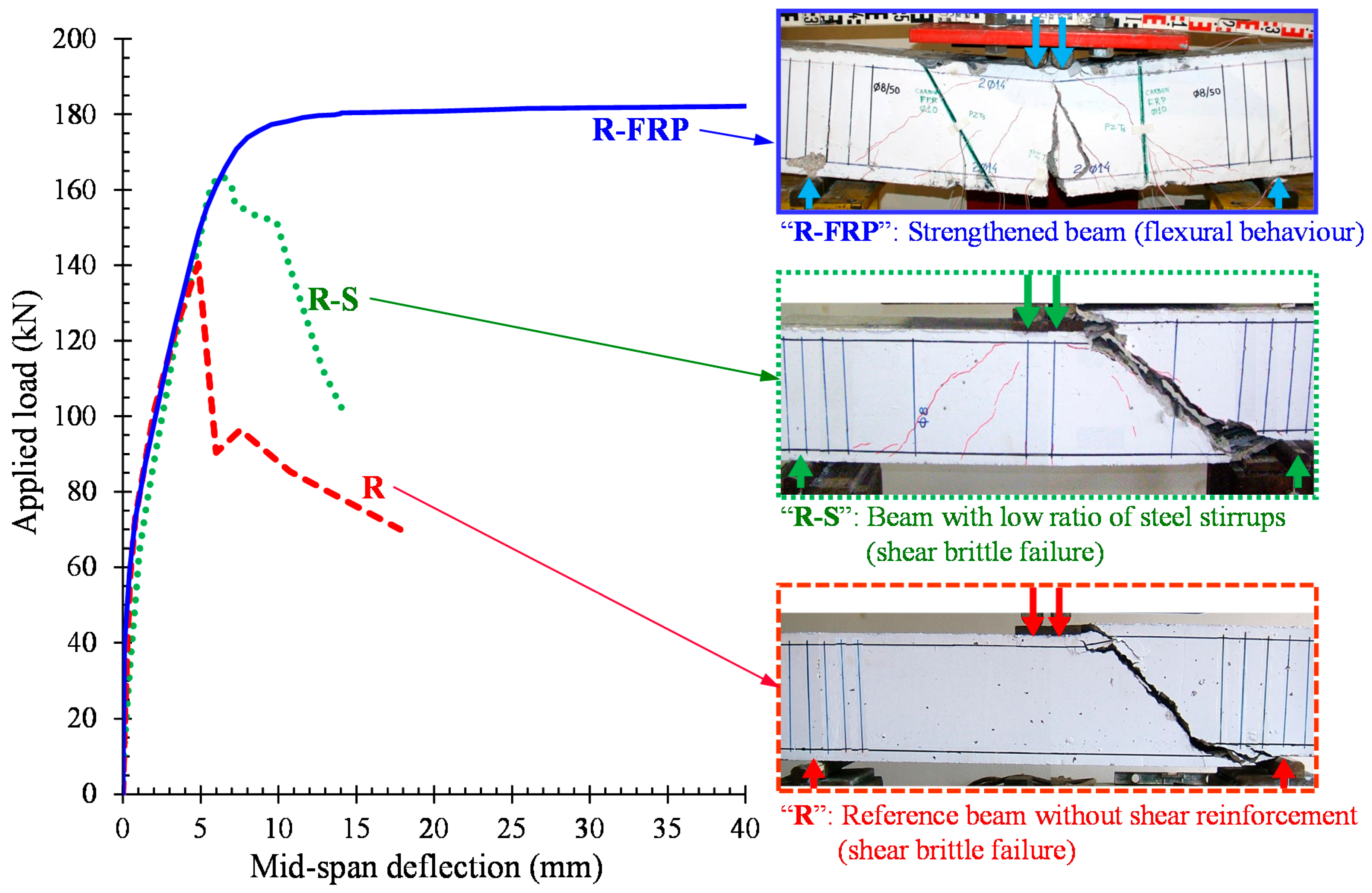
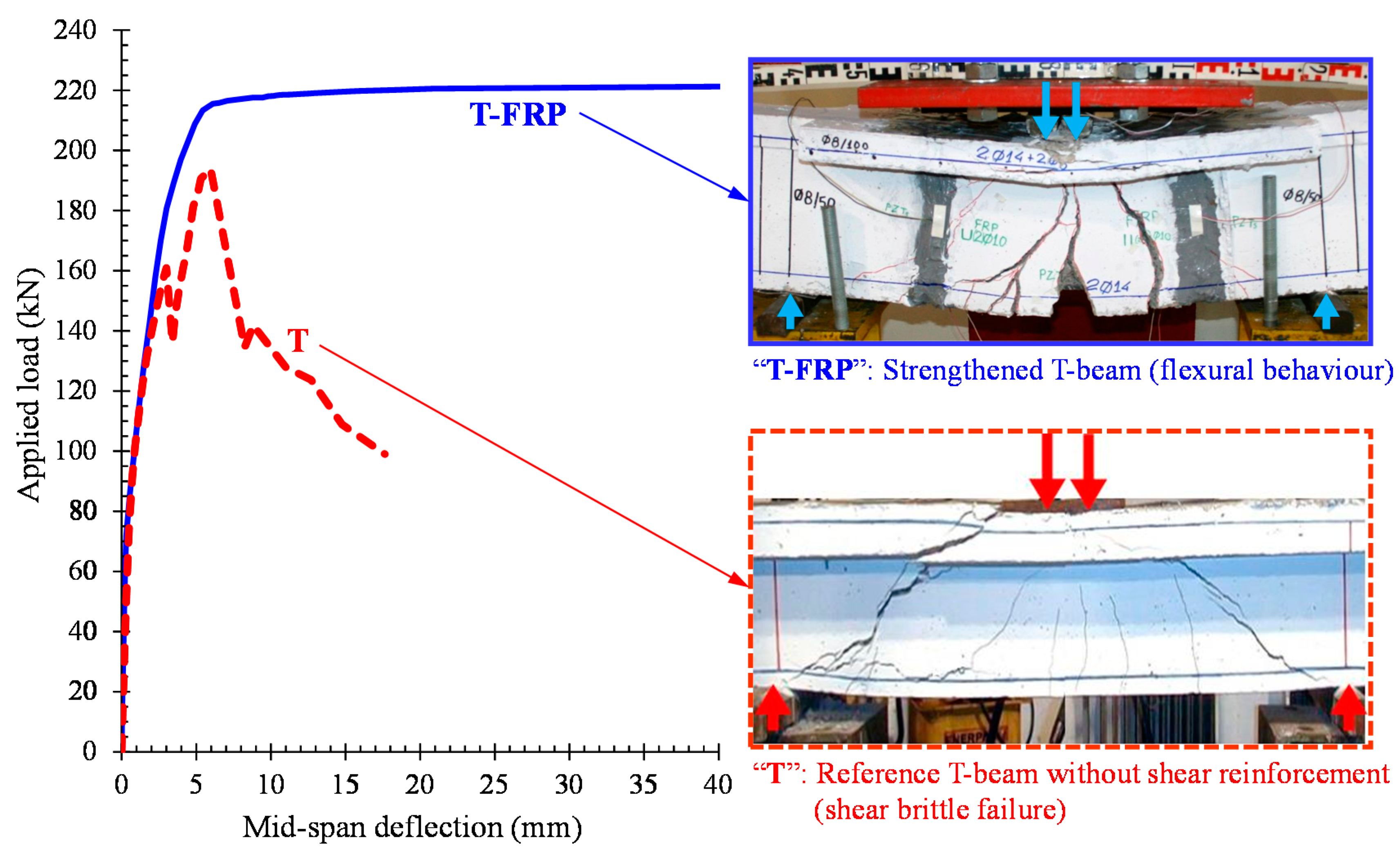
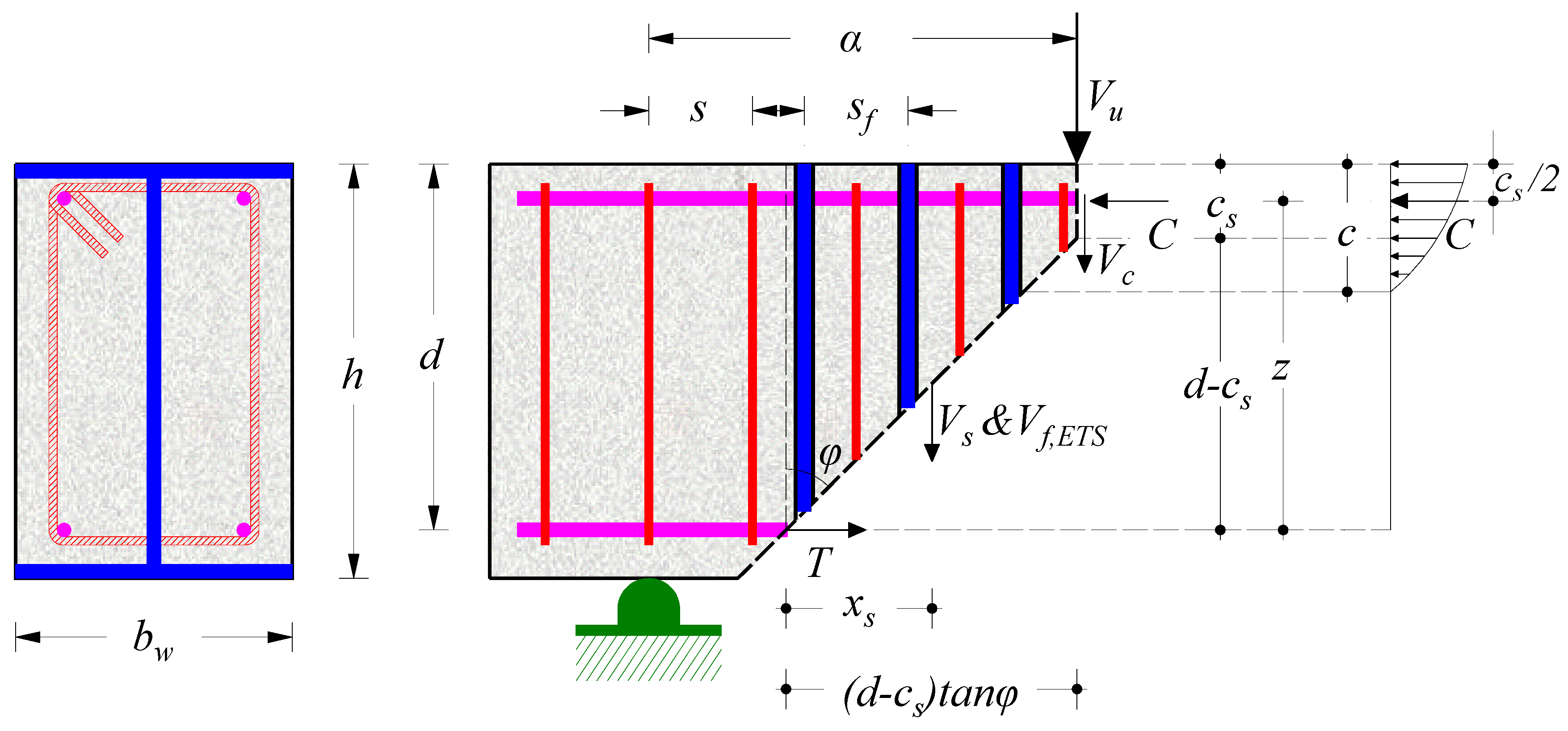
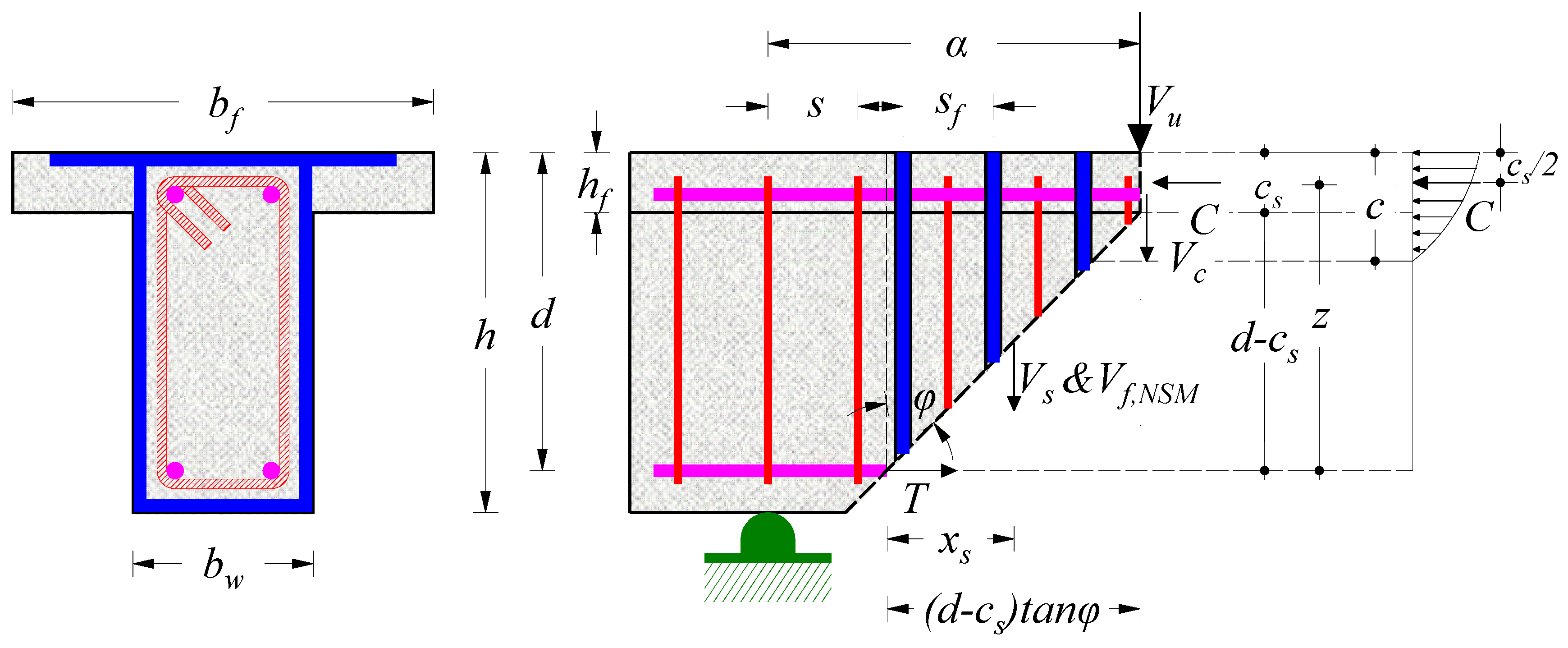
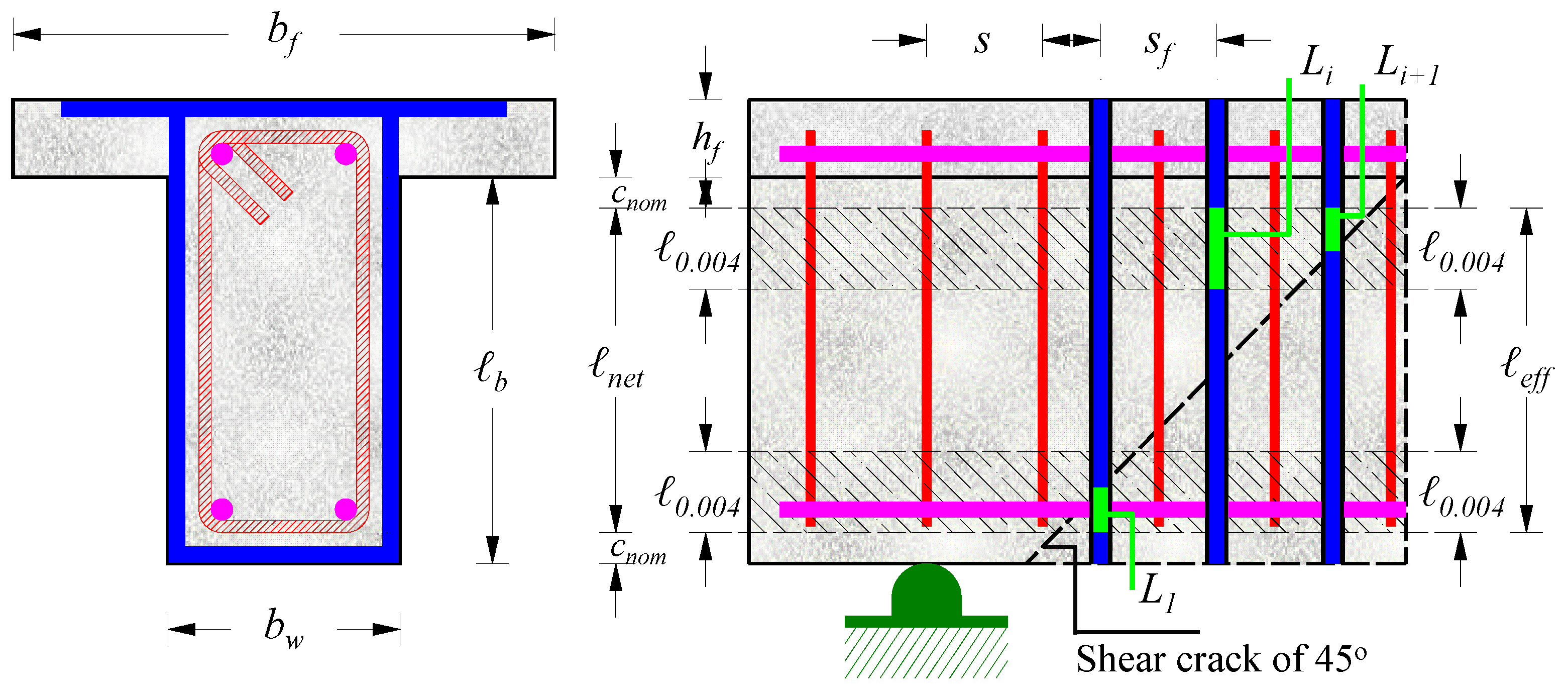
| Beam Codified Name | Experimental Results | Analytical Predictions | ||||||||
|---|---|---|---|---|---|---|---|---|---|---|
| Pu,exp (kN) | Vu,exp (kN) | Failure Mode 1 | My,calc (kNm) | PMy,calc (kN) | Mu,calc (kNm) | PMu,calc (kN) | VVu,calc (kN) | PVu,calc (kN) | Failure Mode 1 | |
| R | 140.4 | 70.2 | Sh | 42.3 | 169.2 | 43.9 | 175.6 | 70.8 | 141.6 | Sh |
| R-S | 163.8 | 81.9 | Sh | 42.3 | 169.2 | 43.9 | 175.6 | 82.7 | 165.4 | Sh |
| R-FRP | 182.2 | 91.1 | Fl | 42.3 | 169.2 | 43.9 | 175.6 | 124.1 L | 220.8 | Fl |
| 110.4 R | ||||||||||
| T | 194.0 | 97.0 | Sh | 44.8 | 224.0 | 46.8 | 234.0 | 113.2 | 226.4 | SY |
| T-FRP | 221.4 | 110.7 | Fl | 44.8 | 224.0 | 46.8 | 234.0 | 153.3 | 306.6 | Fl |
© 2018 by the authors. Licensee MDPI, Basel, Switzerland. This article is an open access article distributed under the terms and conditions of the Creative Commons Attribution (CC BY) license (http://creativecommons.org/licenses/by/4.0/).
Share and Cite
Chalioris, C.E.; Kosmidou, P.-M.K.; Papadopoulos, N.A. Investigation of a New Strengthening Technique for RC Deep Beams Using Carbon FRP Ropes as Transverse Reinforcements. Fibers 2018, 6, 52. https://doi.org/10.3390/fib6030052
Chalioris CE, Kosmidou P-MK, Papadopoulos NA. Investigation of a New Strengthening Technique for RC Deep Beams Using Carbon FRP Ropes as Transverse Reinforcements. Fibers. 2018; 6(3):52. https://doi.org/10.3390/fib6030052
Chicago/Turabian StyleChalioris, Constantin E., Parthena-Maria K. Kosmidou, and Nikos A. Papadopoulos. 2018. "Investigation of a New Strengthening Technique for RC Deep Beams Using Carbon FRP Ropes as Transverse Reinforcements" Fibers 6, no. 3: 52. https://doi.org/10.3390/fib6030052
APA StyleChalioris, C. E., Kosmidou, P.-M. K., & Papadopoulos, N. A. (2018). Investigation of a New Strengthening Technique for RC Deep Beams Using Carbon FRP Ropes as Transverse Reinforcements. Fibers, 6(3), 52. https://doi.org/10.3390/fib6030052






